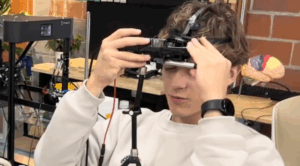
Leica has introduced the Q3 Monochrom, a dedicated monochrome camera that promises to redefine the way photographers approach black-and-white imagery. This innovative device compels users to engage with their surroundings more thoughtfully, as every decision regarding light, texture, and timing becomes crucial when operating without color.
In a detailed review, photographer Tonelli highlights the camera’s design and functionality. The Q3 Monochrom features a matte black finish, with understated white and gray markings, creating a low-profile appearance that is less conspicuous for street photography. Its compact shape, complemented by a leather wrap, retains the familiar feel of the Q series, although an additional grip may be beneficial for extended use.
The camera is equipped with a 60-megapixel monochrome sensor and a fixed 28mm f/1.7 Summilux lens. Initially, images may appear muted with low contrast and gentle tonality, a feature that allows for extensive post-processing in software like Lightroom. Tonelli draws comparisons to medium-format photography, noting how skin tones render and how the camera preserves fine detail in both shadows and highlights. Unlike conventional cameras that simulate black-and-white images, the Q3 Monochrom captures true monochrome data, enabling distinct control over exposure and tonal adjustments.
Performance and Autofocus Capabilities
While examining the autofocus system, Tonelli reveals that the Q3 Monochrom does not include the phase-detection autofocus found in the standard Q3 model. Instead, it relies solely on a refined contrast-detect system. Although this change may seem like a drawback, Tonelli reports that the autofocus performance is surprisingly quick and reliable. He tested the camera in the dynamic environment of Singapore, successfully capturing candid moments without the frustration of constant focus hunting.
Another standout feature of the Q3 Monochrom is its ISO performance. The camera boasts an impressive ISO range from 100 to 200,000. During testing, Tonelli demonstrated the camera’s capabilities at extreme settings, revealing that even at ISO 50,000, the images retain clarity and detail, reminiscent of mid-range color systems. At ISO 200,000, while dynamic range may compress, the camera still delivers usable images with discernible details in challenging lighting conditions.
Intended Use and Considerations
Tonelli candidly discusses the niche nature of a dedicated black-and-white camera. He acknowledges that the Q3 Monochrom may not be the ideal choice for color-dependent commercial work. Instead, it serves as a specialized tool for photographers seeking to explore a specific vision. The decision to adopt a fixed 28mm perspective may challenge some users, prompting them to weigh their comfort with a wider field of view against potential cropping.
In terms of user interface, the Q3 Monochrom features a modern touch-friendly menu, streamlining settings adjustments in the heat of the moment. Nevertheless, Tonelli notes that certain features, such as subject detection, still lag behind competitors in the premium camera market, highlighting the ongoing tension between traditional photographic experiences and modern technological expectations.
The Q3 Monochrom stands as a compelling option for photographers eager to immerse themselves in the art of black-and-white photography. Through its innovative design and robust performance, it encourages users to engage with their craft in a deliberate and thoughtful manner. For those curious about the intricacies of this camera, Tonelli’s comprehensive review offers valuable insights into its potential and performance.







